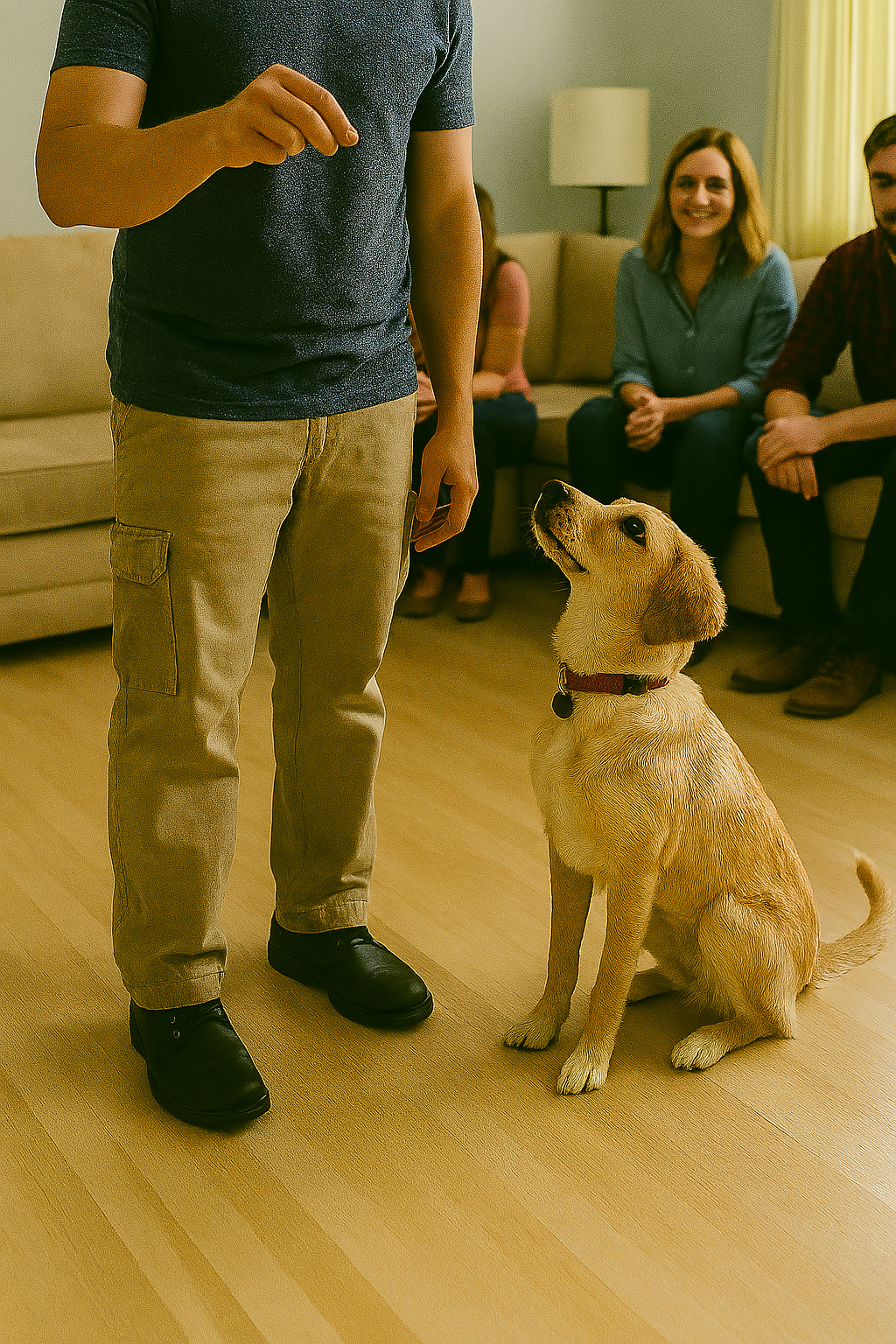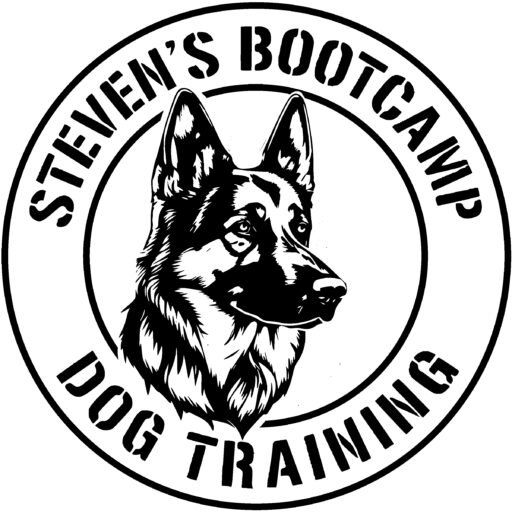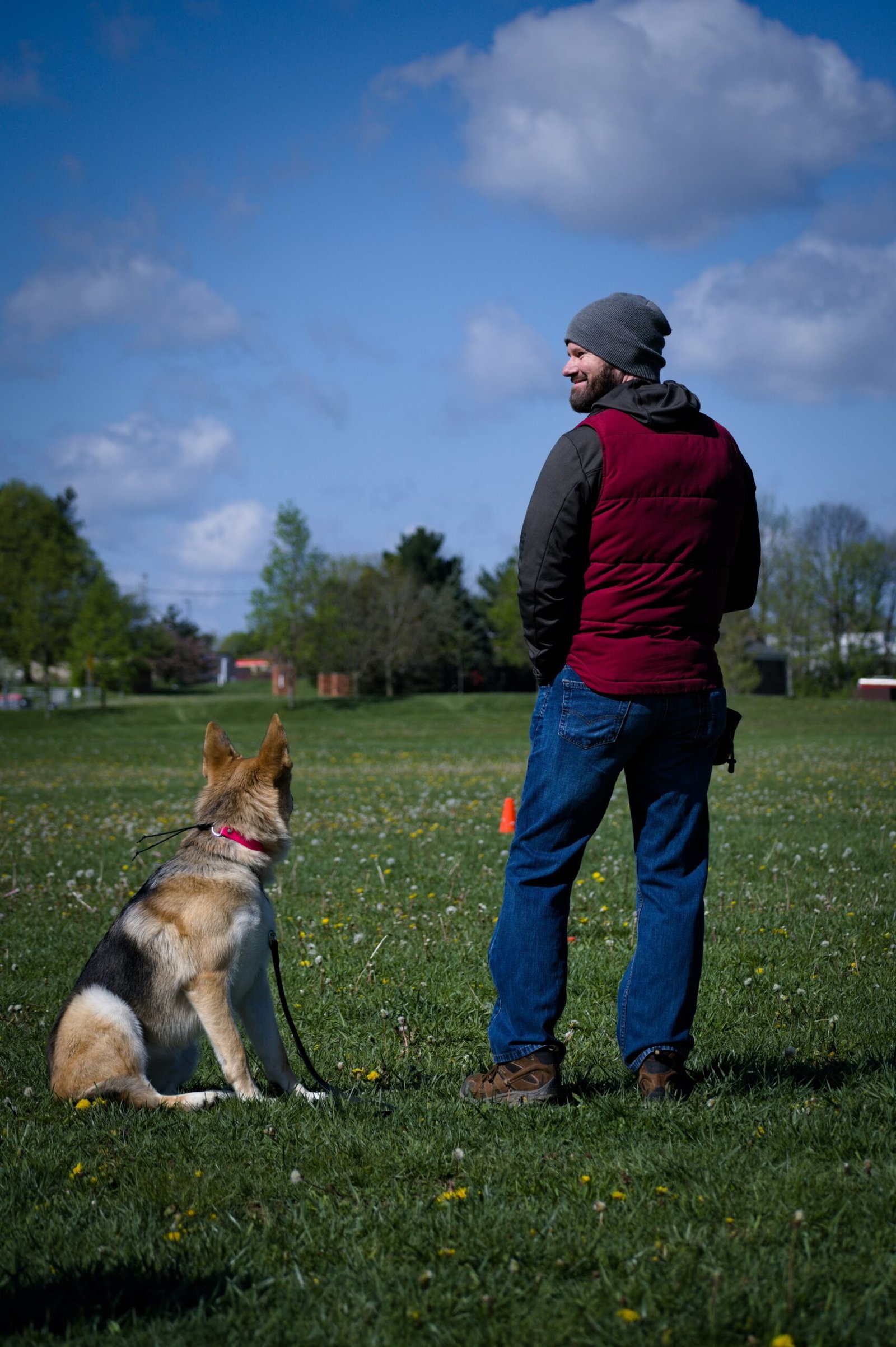In-Home Dog Training Program
Quality obedience training where you and your dog feel most comfortable.

Discover Our In-Home Training Program
Our In-Home Training Program offers a distinctive approach to dog training by providing expert guidance in the comfort of your home, allowing clients to choose between two balanced training methods for general obedience: with the use of an e-collar or without. Both options follow a training philosophy that reinforces positive behaviors while addressing inappropriate actions through corrections. The e-collar option streamlines the process, requiring seven sessions, while the traditional method involves a longer commitment of ten sessions, necessitating more time and patience. Despite the differences in approach, both options focus on the same fundamental discipline, ensuring flexibility for our clients to select the training that best aligns with their needs. All In-Home training packages include 6 months of Group Classes after the dog graduates from the training program.
What To Expect From The In-Home Training Program
OVERVIEW
We bring the training directly to your home, where your dog feels most secure and relaxed. These are one-hour sessions with a professional trainer that will work with your dog in its familiar environment, while also guiding household members through the process to ensure everyone is involved and confident. This program is ideal for families with nontraditional schedules, individuals with mobility limitations, and households where multiple people need to understand and participate in the training. It’s a personalized, inclusive approach that meets your dog’s needs while empowering your entire family.
IN-HOME DOG TRAINNG HAS OPTIONS
We proudly offer both e-collar training and balanced positive reinforcement programs, each thoughtfully tailored to meet the unique needs of every dog and their family. Our e-collar program includes seven In-Home sessions, while our balanced positive reinforcement program consists of ten In-Home sessions. We typically schedule these sessions at least one week apart to give families ample time to practice and reinforce the most recently introduced command. After each session, we provide clear, structured “homework” to help guide your practice at home. Your consistent involvement between sessions is essential to the success of the training—your commitment helps ensure lasting results and a stronger bond with your dog.
SUPPORT
Each In-Home Training Program at Steven’s Bootcamp Dog Training includes six months of Group Classes—an essential component of your dog’s learning journey. These classes are designed to help dogs generalize commands and build reliable obedience, even in the presence of distractions. The value of Group Classes cannot be overstated: they play a critical role in reinforcing training and ensuring your dog can respond confidently in real-world settings. While many facilities charge significantly for this type of ongoing support, we include it FREE in every training package as a reflection of our commitment to your dog’s long-term success. Group Classes also provide vital opportunities for socialization and environmental acclimation, helping dogs become well-adjusted, confident companions in a variety of settings.
WHAT WE PROVIDE
Steven’s Bootcamp Dog Training provides all the essential tools to support your dog’s success during the program. Each participant receives a 4-foot training leash and a training cot appropriately sized to match your dog’s estimated adult dimensions. We also supply training rewards; however, if you prefer your dog to be trained using their regular kibble, we kindly ask that you provide it. For programs that include e-collar training, we’ll select and supply an e-collar tailored to your dog’s size and weight. If additional tools are needed, such as a prong collar, plastic prong, or slip lead, we will provide those as well, but only after receiving your explicit permission, ensuring that every training method aligns with your comfort and your dog’s needs.
Come “Recall”
The “Come” command is one of the most essential and practical behaviors a dog can learn. It’s not just about getting the dog to approach, it’s about teaching them to complete the recall by making physical contact, typically through a hand touch. This added step is crucial because it ensures the dog comes close enough for you to safely clip on a leash or secure their collar. Without this clear expectation, many dogs begin to develop what’s known as “drive-by” or “halfway” recall behavior, where they approach but stop short or veer off, because the command lacks a defined conclusion. By incorporating the hand touch, you reinforce precision and consistency, turning a basic recall into a reliable, actionable skill.
SIT and BREAK
“Sit” is one of the most essential commands in dog training, yet it’s often underdeveloped. Your dog should be able to Sit, remain in that position even if you leave the room, and hold that command until you return and give a clear release. That level of obedience isn’t just possible—it’s expected in our training.
We don’t use the word “Stay” because that expectation is already built into every command. “Break” is our release cue, signaling the dog is free to move and return to their natural rhythm. This clarity eliminates confusion and builds consistency across all commands.
To reinforce this structure, we focus on the 3Ds: Distance (your dog responds even when you’re far away), Distraction (they stay focused despite tempting stimuli), and Duration (they hold the command for extended periods). These elements are the foundation of reliable obedience and will be a recurring theme throughout our training. Mastering the 3Ds is what transforms casual compliance into true control.
PLACE
Let’s introduce your dog to the “Place” command using the training cot, a cornerstone of foundational obedience. This command teaches your dog to mount the cot and remain there until released or given a new command, reinforcing impulse control and focus through the 3Ds: Distance, Distraction, and Duration. The cot’s elevated design and defined edges provide a clear physical boundary, making it easier for your dog to understand and respect the designated area. Once mastered, “Place” becomes a versatile tool beyond the cot itself. You’ll be able to direct your dog to settle on a towel, park bench, tree stump, or nearly any object with a defined surface, expanding the command’s utility in real-world scenarios. Whether you’re managing household chaos or navigating public spaces, “Place” offers a reliable way to anchor your dog’s behavior with calm, confident control.
HEEL – More than just a walk
“Heel” is a foundational obedience skill that teaches your dog to walk calmly at your side, typically on your left, with their shoulders aligned to your leg. While it may appear straightforward, Heel is one of the most technically demanding commands in general obedience. It requires your dog to maintain consistent focus on the handler, ignore environmental distractions, match your pace, and respond fluidly to directional changes. Each of these components, attention, impulse control, spatial awareness, and movement synchronization, demands targeted training. At Steven’s Bootcamp Dog Training, we isolate these elements and build them step by step, using clear markers, purposeful repetition, and scenario-based practice. By layering these skills gradually, we create a reliable Heel that transforms walks into calm, connected experiences. Whether you’re navigating busy sidewalks or enjoying a quiet trail, a well-trained Heel enhances safety, strengthens your bond, and sets the tone for respectful, responsive behavior in any setting.
DOWN
The Down command builds on many of the same foundational disciplines as Sit, reinforcing calm, controlled behavior. Again, we never use the “Stay” command because it should be assumed into every command, Down included, so the dog learns that holding the position is part of the command. To strengthen this understanding, we apply the 3Ds: Distance (responding reliably even when the handler is farther away), Distraction (maintaining focus despite tempting stimuli), and Duration (holding the position for extended periods).
OFF and QUIET
At Steven’s Bootcamp Dog Training, we focus on just two correction commands: Quiet and Off. The Quiet command is specifically designed for dogs who bark excessively due to boredom, separation anxiety, or reactions to people. It’s important to note, this is not about taking away your dog’s natural voice. Barking is a healthy, necessary behavior, especially when someone knocks at the door. However, once you give the Quiet command, barking should stop immediately. This command is exclusively taught through our e-collar program to ensure clarity and consistency.
The Off command addresses the remaining 99.5% of unwanted behaviors. Whether your dog jumps on guests, counter-surfs, raids the trash, or digs up the yard, Off is the universal cue to interrupt and redirect those actions. While we can’t replicate every possible misbehavior during training, we do provide targeted support for common issues like jumping, digging, and trash scavenging. For the rest, we’ll equip you with the tools and understanding to continue reinforcing good habits at home.


